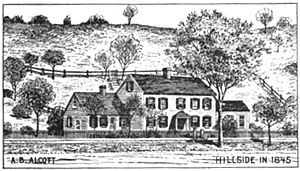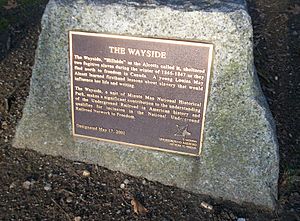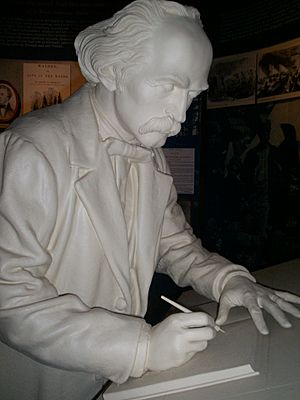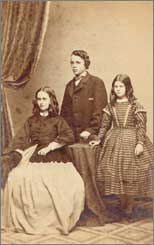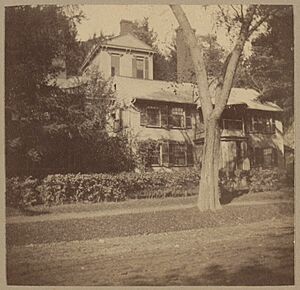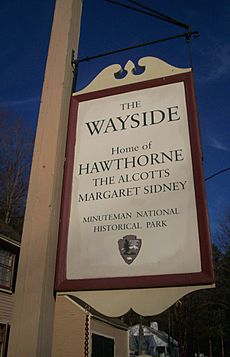The Wayside facts for kids
|
The Wayside
|
|
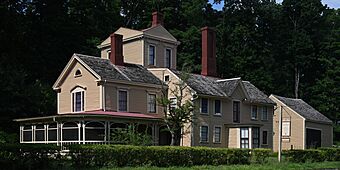
|
|
| Lua error in Module:Location_map at line 420: attempt to index field 'wikibase' (a nil value). | |
| Location | Concord, Massachusetts |
|---|---|
| Architectural style | Colonial |
| NRHP reference No. | 80000356 |
Quick facts for kids Significant dates |
|
| Added to NRHP | July 11, 1980 |
| Designated NHL | December 29, 1962 |
The Wayside is a very old and special house in Concord, Massachusetts. The first parts of this home might have been built as early as 1717. Over the years, it became the home of several famous writers.
First, the young Louisa May Alcott and her family lived here, and they called it Hillside. Later, the famous author Nathaniel Hawthorne and his family moved in. After them, a children's writer named Margaret Sidney lived there. The Wayside was the very first place connected to a writer that the National Park Service bought to protect. Today, you can visit it as part of Minute Man National Historical Park.
Contents
Early History of The Wayside House
The first time we find records of The Wayside property is in 1717. A Minuteman named Samuel Whitney lived in this house. It looked much like it did when it was first built. On April 19, 1775, British soldiers marched right past the house. They were on their way to the Battles of Lexington and Concord at Concord's Old North Bridge.
From 1775 to 1776, a scientist named John Winthrop lived in the house. This was when Harvard College had to move to Concord for nine months.
The Alcott Family at Hillside
After a project called Fruitlands didn't work out, the teacher and thinker Amos Bronson Alcott and his family moved to Concord. In October 1844, they first stayed with a friend. Bronson's wife, Abby May, had recently received about $2,000. They planned to use this money to buy their own home.
Their neighbor, Ralph Waldo Emerson, helped them find a house. It had belonged to a wheel maker named Horatio Cogswell. Emerson even loaned the Alcotts $500 to help them buy it. Bronson Alcott didn't want to be involved in buying the house. He felt that he couldn't truly own any part of the Earth. No one knew much about the house's past. However, Henry David Thoreau shared a story that a previous owner believed he would never die. People even rumored that his ghost haunted the place. The Alcotts moved in on April 1, 1845, and they named their new home "Hillside."
Renovating Their New Home
The Alcotts immediately started fixing up the house. It was originally a colonial saltbox style home. They cut a shed on the property in half and attached each piece to the sides of the main house. Outside, they added pretty terraces, arbors, and pavilions. Bronson hoped his brother Junius and his family would move in with them. He even built extra rooms for them. But instead, Junius became unwell that summer, and Bronson left to care for him.
In March 1846, the family added a bedroom for their 13-year-old daughter, Louisa May Alcott. It was the first room she had all to herself. She wrote in her journal, "It does me very good to be alone, and Mother has made it very pretty and neat for me." In this house, Louisa and her sisters experienced many things that later appeared in her famous book Little Women (1868–69). This included the plays they put on for fun. She also started writing what would become her first book, Flower Fables (1854).
A Stop on the Underground Railroad
Bronson Alcott welcomed many people into his home. This included Sophia Foord, a teacher he hoped to open a school with. He also offered the house as a safe place for the Underground Railroad. This was a secret network that helped enslaved people escape to freedom. The family likely hosted several people who had escaped slavery. Years later, Louisa May mentioned sheltering more than one person.
Because of the need for secrecy, there are not many records of specific people who stayed there. Bronson mentioned a 30-year-old man who was "athletic, dexterous, sagacious, and self-relying." This man stayed for a week in 1847 on his way to Canada. Bronson hoped this experience would teach his family important lessons.
By 1848, the family started thinking about moving. Bronson liked Concord because he could talk with his neighbors. But Abby saw the town as a sign of their money troubles. She wanted to move to Boston to be closer to friends, family, and possible work. Abby won the discussion. The family rented out Hillside and moved to the South End by that winter.
The Hawthorne Family's Time
After living in a rented home for a while, author Nathaniel Hawthorne decided to buy a house for his family. He told his wife, Sophia Peabody, that his publishers would give them money if they needed it to buy a house. On March 8, 1852, Hawthorne bought the house from the Alcotts for $1,500.
After buying it, Hawthorne wrote that Mr. Alcott had spent a lot of money fixing it up. He felt he was getting those improvements for very little. He also said the place was "the raggedest in the world" but would become a comfortable home. The Hawthornes had lived in Concord before, at The Old Manse. They moved into their new home with their three children in June. Nathaniel renamed it "The Wayside." He thought it was a better name because it was so close to the road, like a coach stop. Bronson Alcott never accepted the new name and kept calling it "Hillside."
In 1852, the Hawthornes hired Henry David Thoreau to survey their property. Their six-year-old son, Julian Hawthorne, quietly went with him. Thoreau told Julian's father that he was a "good boy! Sharp eyes, and no tongue." By October 1852, Hawthorne wrote to his friend Henry Wadsworth Longfellow, saying he was starting to feel truly at home for the first time.
Hawthorne Family Travels to Europe
The family moved to England when Nathaniel Hawthorne became the United States consul in Liverpool. He worked in that role from August 1, 1853, to October 12, 1857. Before they left, on June 14, 1853, their friend and poet Henry Wadsworth Longfellow held a farewell dinner. It was at his Cambridge home.
The Hawthornes stayed in Europe until 1860. During that time, they rented The Wayside to family members. This included Sophia's sister, Mary Peabody, who later married Horace Mann. While Mary lived in the house, Franklin Benjamin Sanborn stayed there for a night. He was hiding his connection to John Brown and a historical event. The Hawthornes' son Julian later went to Sanborn's school. Before returning to the United States, the Hawthornes spent several months in Italy.
While the Hawthornes were overseas, the Alcotts had Henry David Thoreau survey the land next door to The Wayside. This land had been the home of a man named John Moore. It had elm and butternut trees and an apple orchard. The Alcotts bought this home, which they named Orchard House, on September 22, 1857. The Hawthornes called it "Apple Slump." While Orchard House was being fixed up, the Alcott family rented a part of The Wayside.
Unlike Bronson Alcott, Nathaniel Hawthorne was not known for spending time with his neighbors. He often used the hilltop in his backyard to avoid talking to people. Bronson noted that Hawthorne "feared his neighbor's eyes would catch him as he walked." However, the children from both families became good friends. Bronson was sad that he couldn't connect with Nathaniel. Louisa May was surprised the families didn't become closer friends.
Returning to the United States
After the family came back to the United States in 1860, Nathaniel thought about moving to Boston. He wondered how they would fit into their "little old cottage." The money from his consul job was not as much as he expected. Also, his latest book, The Marble Faun, was not very popular.
Hoping to make The Wayside bigger instead of moving, he worried about money. He needed to build an addition to the house, educate his daughters, and send Julian to Harvard College. Despite this, the family made several changes to the home. The most notable was the three-story tower added to the back of the house. The top room became Nathaniel's study. He called it his "sky parlor." However, the tin roof made the room very hot in summer and very cold in winter. During those months, he used the front living room for his writing. Julian Hawthorne moved his bedroom to the first-floor sitting room.
Their next-door neighbor, Bronson Alcott, created paths and planted gardens for the Hawthornes. These included fir trees and larches brought from England. Thoreau also surveyed the property for $10. The Hawthornes also added a second story over Alcott's west wing. They enclosed the bay porch and moved the barn to the east side of the house. Nathaniel was not completely happy with the result. He wrote in January 1864 that he had turned a simple farmhouse into "the absurdest anomaly you ever saw." He blamed the village carpenter for not building what he asked for.
During these years, Nathaniel turned down invitations to write for The Atlantic Monthly. When the magazine was bought by publisher James T. Fields, he invited both Nathaniel and Sophia to write. Nathaniel agreed, but Sophia said no. She wrote that Nathaniel was the "Belleslettres portion of my being." She also said she didn't like female authors in general, and especially herself as one.
The Civil War Years and Beyond
When the American Civil War began, Nathaniel Hawthorne's spirits and health were declining. His friend Horatio Bridge urged him to take a trip to Washington, D.C.. There, he met President Abraham Lincoln in the spring of 1862. Nathaniel noted that Lincoln was "about the homeliest man I ever saw" but that he "liked this sallow, queer, sagacious visage." He visited several places related to the War and the Army, especially in Virginia. He traveled for a time with writer Nathaniel Parker Willis.
He returned to The Wayside on April 10, 1862. Less than a month later, he sent The Atlantic an essay called "Chiefly About War Matters by a Peaceable Man." Fields, the editor, had gone on the trip with Nathaniel at Sophia's request. He insisted on changes to the essay. He and his publishing partner William Ticknor agreed that comments about President Lincoln's looks and references to "Uncle Abe" should be removed. Nathaniel cut the whole section, even though he thought it was the "only part of the article really worth publishing." He felt sad about trying to share a bit of truth in a world full of "humbug." The Atlantic received "cruel and terrible notes" after the article was published, Fields claimed.
In his later years, Nathaniel worried a lot about his family's money after he died. Living at The Wayside cost the family $2,500 a year. This was despite trying to save money by not hiring help for the house and grounds. He told his publisher that he expected to "die in the alms-house." In the late spring of 1864, Nathaniel became ill. He traveled with his friend, former President of the United States Franklin Pierce. It was on this trip that Nathaniel died on May 19, 1864.
When she heard the news, Louisa May Alcott sent the family a bouquet of violets. She had picked them from Nathaniel's walking path by The Wayside. Annie Adams Fields, the publisher's wife, visited in April 1865. She wrote in her journal, "What an altered household! She [Sophia] feels very lonely, and is like a reed." Sophia and her three children moved to England shortly after. She sold The Wayside in 1870.
The Lothrop Family and Margaret Sidney
The home was bought in the spring of 1879 by George Parsons Lathrop. He was an author and the husband of Hawthorne's daughter, Rose. Rose and George Lathrop lived there with their son, Francis. Rose had lived there twice before and hoped it would be a happy time for her young family. But it was not; their son became very sick. The Lathrops moved out on February 6, 1881, the day young Francis died.
In 1883, The Wayside was bought by Boston publisher Daniel Lothrop and his wife, Harriett. Harriett was the author of the Five Little Peppers series and other children's books. She used the pen name Margaret Sidney. The Lothrops made many improvements to the house. They added town water in 1883, central heating in 1888, and electric lighting in 1904. They also added a large porch on the west side in 1887. The room that had been Julian Hawthorne's bedroom became Mrs. Lothrop's dining room.
The Lothrops helped organize a celebration for Nathaniel Hawthorne's 100th birthday in 1904. Speeches were given, letters were read in public, and a special plaque was dedicated. Beatrix Hawthorne, Julian's daughter, marked the larch path where the author often walked. Hawthorne's daughter Rose, who was then known as Mother Mary Alphonsa, could not attend. She was leading the Dominican Sisters of Hawthorne in New York. She wrote that she had no way to be there. She explained that her work caring for the sick and dying kept her very busy.
The Wayside Today
After Margaret Sidney passed away in 1924, her daughter inherited the home. She opened the house to the public in 1927. Margaret Sidney, who had the same name as her mother, spent 40 years taking care of the home. She researched and wrote about its history and gave tours. The house stayed in the Lothrop family until 1965.
In 1963, The Wayside was named a National Historic Landmark. It became part of Minute Man National Historical Park on June 15, 1965. This happened with help from the Lothrops' daughter, Margaret. It was the first place connected to a writer to be bought by the National Park Service.
The Wayside was renovated in 1969 and 1970. For many years after that, the National Park Service only did small repairs. Then, the building was closed in 2013 for a major restoration. It reopened in June 2016. The inside of the house is kept to look like it did when Margaret Sidney passed away in 1924.
Today, The Wayside is open to the public during certain seasons for guided tours. You can find it at 455 Lexington Road in Concord.
See also


